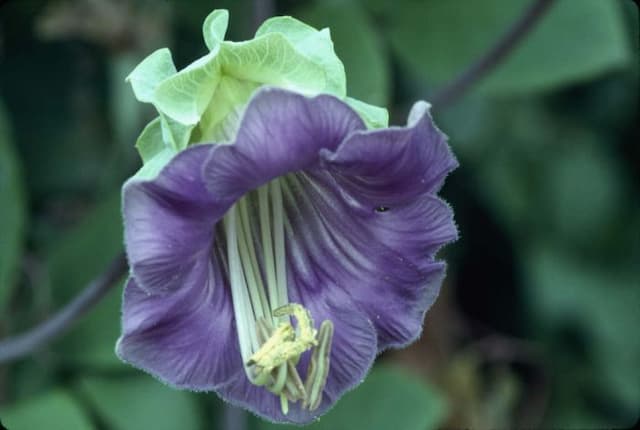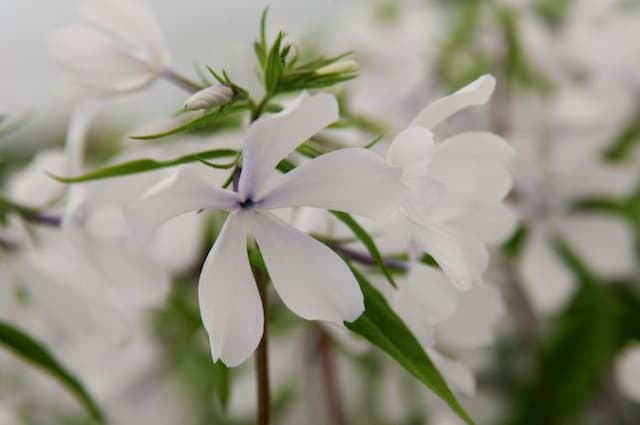Garden Phlox Phlox paniculata 'Starfire'

ABOUT
Phlox paniculata 'Starfire' is a perennial plant known for its vibrant flower clusters. The plant features sturdy stems that are topped with dense, pyramidal panicles of blossoms. The flowers of 'Starfire' are particularly striking, boasting a rich, cherry red hue that adds a bold splash of color to any garden setting. Each individual flower displays a rounded shape with five petals that are slightly overlapping, forming a star-like pattern that is characteristic of this variety. The blossoms emit a pleasant fragrance that can attract pollinators such as butterflies and hummingbirds. The foliage of 'Starfire' is a dark green color, with leaves that are lance-shaped and can have a slightly glossy appearance. The contrast between the deep green leaves and the fiery red blooms creates a dramatic visual impact. This plant blooms profusely in the summer months and, if properly deadheaded, can extend its flowering period. Overall, Phlox paniculata 'Starfire' is appreciated for its showy flowers and the lively atmosphere it can bring to gardens.
About this plant
 Names
NamesFamily
Polemoniaceae
Synonyms
Garden Phlox, Summer Phlox, Perennial Phlox, Fall Phlox, Tall Phlox
Common names
Phlox paniculata 'Starfire'.
 Characteristics
CharacteristicsLife cycle
Perennials
Foliage type
Deciduous
Color of leaves
Green
Flower color
Red
Height
3-4 feet (0.91-1.22 meters)
Spread
2-3 feet (0.61-0.91 meters)
Plant type
Herb
Hardiness zones
4-8
Native area
North America
Benefits
 General Benefits
General Benefits- Colorful Blooms: Phlox paniculata 'Starfire', commonly known as garden phlox, produces vibrant red flowers that add a burst of color to any garden.
- Attracts Pollinators: The flowers of garden phlox are attractive to butterflies and hummingbirds, aiding in pollination.
- Summer Flowering: As a summer-blooming perennial, it provides seasonal interest when many other plants have finished their bloom cycle.
- Fragrance: The blooms emit a sweet fragrance, which can add a pleasant scent to your garden or outdoor living area.
- Cut Flowers: Its stems are sturdy and long-lasting, making garden phlox an excellent choice for use in floral arrangements.
- Drought Tolerance: Once established, garden phlox has moderate drought tolerance, making it suitable for gardens with limited water availability.
- Versatility: This plant can be used in borders, cottage gardens, and perennial beds, offering a variety of landscaping opportunities.
- Easy to Grow: Phlox paniculata 'Starfire' is relatively easy to care for and can be grown by gardeners of all skill levels.
- Deer Resistance: It is known to be somewhat resistant to deer, which can be beneficial in areas where deer browsing is a problem.
 Medical Properties
Medical PropertiesThis plant is not used for medical purposes.
 Air-purifying Qualities
Air-purifying QualitiesThis plant is not specifically known for air purifying qualities.
 Other Uses
Other Uses- Garden Phlox can be used as a natural dye, with different parts of the plant producing various hues on textiles.
- It can serve as a marker of seasonal change in educational settings, illustrating phenology by its flowering patterns.
- Garden Phlox is sometimes utilized in art projects or pressed flower crafts, providing color and texture.
- The flowers are edible and can be used as a decorative, flavorful addition to salads or as garnish on desserts.
- Phlox paniculata 'Starfire' can be used in sensory gardens due to its fragrant flowers, which can offer an olfactory experience.
- Its stems, when dried, can be incorporated into wreaths and other dried floral arrangements for long-lasting decorations.
- In photography, the vibrant blossoms can act as an attractive backdrop or subject for macro photography.
- Garden Phlox can be used as a tool for teaching plant breeding and hybridization in educational programs about horticulture.
- By planting Garden Phlox, one can attract and support local butterfly populations, contributing to biodiversity and ecosystem health.
- The plant’s structure can be used in physics or botany experiments to understand capillary action and water uptake in plant stems.
Interesting Facts
 Feng Shui
Feng ShuiGarden Phlox is not used in Feng Shui practice.
 Zodiac Sign Compitability
Zodiac Sign CompitabilityGarden Phlox is not used in astrology practice.
 Plant Symbolism
Plant Symbolism- Harmony: The name "phlox" is derived from the Greek word meaning "flame," which symbolizes a harmonious blend of colors akin to a gentle fire.
- Unity: With its dense clusters of flowers, the garden phlox often represents unity or coming together of hearts.
- Proposal: In the language of flowers, garden phlox can be used to symbolize a proposal or an offer of love.
- Sweet Dreams: The garden phlox's sweet fragrance is associated with providing one with sweet dreams when planted near bedrooms or under windows.
 Water
WaterGarden Phlox should be watered deeply once a week, providing about an inch of water each time. During hot or dry periods, increase the frequency to twice a week, ensuring the soil remains moist but not soggy. Overhead watering should be avoided to prevent mildew issues; instead, use a soaker hose or water at the base of the plants. Adjust your watering to the plant's needs, considering rainfall and the specific conditions of your garden. Garden Phlox requires consistent moisture, so if the week is particularly dry, don't hesitate to water more frequently. Always aim to mimic natural rainfall, providing enough water to reach deep into the root system, which typically means using about 0.5 gallons per square foot every week under normal conditions.
 Light
LightGarden Phlox thrives best in full sun, which means it needs at least six hours of direct sunlight each day. They can tolerate partial shade, especially in hotter climates, but flowering is optimal when the plant is placed in a location with ample sunlight. Ensure that the chosen spot gets morning sun, which is less harsh than the intense afternoon sun, and provides a well-lit environment throughout the day for vibrant blooms.
 Temperature
TemperatureGarden Phlox is hardy in a range of temperatures and can survive in minimum temperatures as low as -30 degrees Fahrenheit, which corresponds to USDA hardiness zones 4 through 8. Ideally, Garden Phlox prefers the temperate climates found in these zones, flourishing best in temperatures between 60 and 70 degrees Fahrenheit. Extreme heat above 90 degrees Fahrenheit can stress the plants, so providing some afternoon shade in hotter regions can be beneficial.
 Pruning
PruningGarden Phlox should be pruned to promote bushier growth and to prevent disease by increasing air circulation. Deadheading, or removing spent flowers, will encourage more blooms and extend the blooming period. Pruning should be done in early spring to remove any dead or diseased stems and can be repeated after the first bloom to maintain shape and appearance. The best time for major pruning is in late winter or early spring before new growth starts.
 Cleaning
CleaningAs needed
 Soil
SoilGarden Phlox requires rich, moist, well-draining soil with a pH of 6.5 to 7.0. A good mix would include garden soil, compost, and perlite or vermiculite to improve drainage.
 Repotting
RepottingGarden Phlox typically does not require frequent repotting and can thrive for several years in the same location. Only repot if the plant outgrows its space or soil is depleted.
 Humidity & Misting
Humidity & MistingGarden Phlox prefers moderate humidity levels but is adaptable to various conditions as long as the soil moisture is maintained.
 Suitable locations
Suitable locationsIndoor
Ensure bright light, ample airflow, and consistent moisture.
Outdoor
Full sun, well-drained soil, and regular watering.
Hardiness zone
4-8 USDA
 Life cycle
Life cycleThe life cycle of Phlox paniculata 'Starfire', commonly known as Garden Phlox, starts with seed germination, typically in spring, after experiencing a period of cold stratification. After germination, the seedlings develop into juvenile plants, growing a rosette of leaves at the soil surface. As the plant matures, it elongates and produces upright stems, upon which leaves are arranged in an opposite fashion. The Garden Phlox reaches the flowering stage in summer, displaying clusters of vibrant red flowers that attract pollinators and may lead to cross-pollination. Following pollination, the plant sets seed in the form of capsules, which upon maturity, release the seeds to complete the life cycle. In fall, the plant begins to die back, retreating to its root system, where it becomes dormant over winter, ready to start the cycle again the following spring.
 Propogation
PropogationPropogation time
Spring-Early Summer
Propogation: The Summer Phlox, like Phlox paniculata 'Starfire', is commonly propagated through stem cuttings. This method is most popular due to its effectiveness in producing true-to-type plants. To propagate by stem cuttings, one would typically take cuttings of new growth in late spring or early summer. The cuttings, about 4 to 6 inches long (10 to 15 centimeters), should have several sets of leaves. The lower leaves are removed, and the cut end of the stem is dipped in rooting hormone powder to enhance root development. Then, the cutting is inserted into a moist soilless potting mix. The pot is kept under a humidity dome or plastic bag to maintain high humidity, and placed in indirect light. Roots usually develop within a few weeks, after which the new plants can be transferred to individual pots and eventually into the garden.









